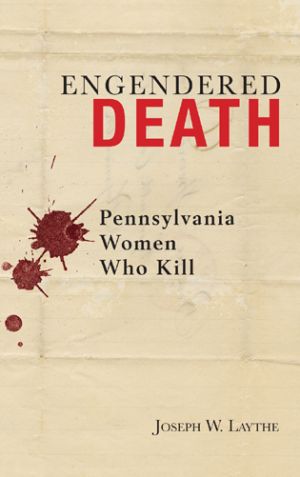Joseph Laythe, Professor of History at Edinboro University, recently published Engendered Death: Pennsylvania Women Who Kill (Bethlehem, PA: Lehigh University Press, 2012). What makes this work particularly unique is its combination of both scholarly analysis and narrative case studies. As such, it will appeal to both the scholar and the reader of true-crime non-fiction.
Engendered Death is an interdisciplinary study of women from the state of Pennsylvania who have committed murder. The study examines the background of each woman, the murder, arrest and trial. It does so, however, through the lens of gender studies. It examines how these women were portrayed in the media and their cases warped by gender expectations. Many of the case studies used are centered in Erie County, including the Torchkiller case of 1930 and the case of Marjorie Diehl-Armstrong.
If we are to recognize the co mplex variables at play in all criminal offenses, we will need to understand that the laws of a community, its social values, its politics, economics, and even geography play a factor in what laws are enforced and against whom they are enforced. The decision to define and label certain behaviors and certain people was based on social, political, and economic considerations of each community. Thus, the commission of murder by a woman in Arizona may have a variety of factors associated with it that are not present in the case of a woman who murdered her husband in Maine. This study, in part because of the volume of cases and in part to limit the variables affecting the cases, has limited its scope of women killers to the state of Pennsylvania. Pennsylvania is the ideal state to study because of its long and stable legal and political traditions, its historically diverse population, and the large number of newspapers that will help us gauge the public’s view of women and women who kill. By limiting our scope to one state, we know that the legal definitions are fairly consistent for all of the women during a certain period and we can more easily identify the shifts in social values regarding women and homicide.
mplex variables at play in all criminal offenses, we will need to understand that the laws of a community, its social values, its politics, economics, and even geography play a factor in what laws are enforced and against whom they are enforced. The decision to define and label certain behaviors and certain people was based on social, political, and economic considerations of each community. Thus, the commission of murder by a woman in Arizona may have a variety of factors associated with it that are not present in the case of a woman who murdered her husband in Maine. This study, in part because of the volume of cases and in part to limit the variables affecting the cases, has limited its scope of women killers to the state of Pennsylvania. Pennsylvania is the ideal state to study because of its long and stable legal and political traditions, its historically diverse population, and the large number of newspapers that will help us gauge the public’s view of women and women who kill. By limiting our scope to one state, we know that the legal definitions are fairly consistent for all of the women during a certain period and we can more easily identify the shifts in social values regarding women and homicide.
